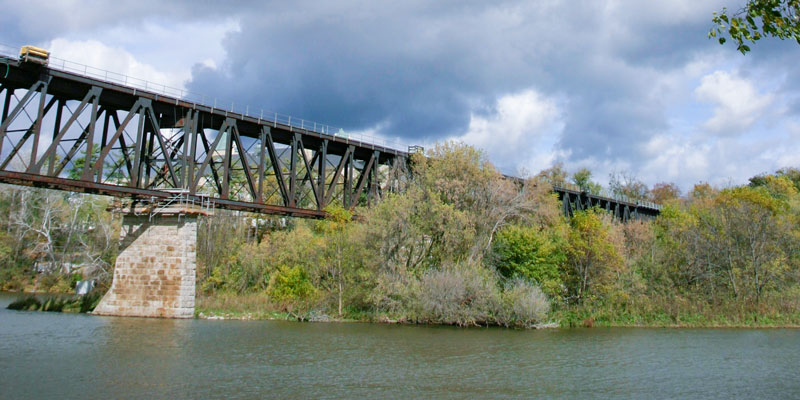Agriculture, Ecology and Urban/Industrial Activities - Cause and Effect Associations in the Occurrence of Waterborne Pathogens
Principal Investigators - James Byrne, Director, Water Resources Institute, University of Lethbridge and James Thomas, Professor (2001-2004)

Challenge
In Canada, waterborne pathogens have resulted in a string of major infections, producing boil water advisories, water treatment facility shutdowns, and expensive treatment plant upgrades. Intestinal pathogens can also cause serious harm to healthy individuals, or even fatal to vulnerable persons, such as the young, old and immuno-compromised. With increasing human activity in both urban and agricultural settings, it’s expected that there will be an increase in fecal contaminant levels, and, subsequently, waterborne pathogens. Yet, there remains little information on variables that affect the growth of pathogen populations, specifically, concerning species-specific sources of fecal contamination and indicators capable of identifying pollution sources.
Within this project, the researchers sought to investigate pathogen sources at the molecular level through identification of species-specific traits, which would allow potential hosts and reservoirs harboring waterborne pathogens to be identified and provide a measure of human health risks associated with recreational and drinking water.
Project
The objectives of the project were to:
- Develop more specific, reliable pathogen identifiers;
- Develop species-specific profiles for E. coli and Salmonella to identify sources of fecal contamination;
- Relate occurrence of waterborne pathogens to environmental, spatial and temporal factors; and
- Link the existing network for communicable disease reporting with spatial analysis techniques to map disease incidence.
The Oldman River Basin, located in the southern part of Alberta, was chosen as the project study site, north of which, there is a highly developed cattle feedlot industry that has the potential to leak into and contaminate surface and ground waters. Between 2001 and 2004, water samples were collected from 42 urban and rural sites within the river basin. Representative site samples were analyzed for basic water chemistry, while all samples were analyzed for the presence of fecal coliforms, E coli and Salmonella. Spatial and temporal occurrence of key populations were then mapped using GIS, and a series of statistical analyses were carried out to establish what human, animal, ecological and water quality variables affected the occurrence of specific pathogens.
Results indicated that fecal contamination in surface waters was low during the winter months, while contamination levels increased during summer months from May through September. The unique spatial characteristics between upstream and downstream sites, and the rise in bacterial contamination following precipitation events, suggested that bacterial contamination resulted from a number of factors other than animal density, such as landscape topology and farm-specific practices. In particular, changes in flow rate and the subsequent sediment impacts were considered to exert an influence on contamination, suggesting that water managers should be prepared to respond to environmental conditions that result in increased turbulence. Conversely, extended periods of low turbulence could result in accumulation of water-borne contaminants.
Outputs
Creation of a new set of multi-disciplinary decision support tools for use in risk assessments.
A number of joint publications, international presentations and Masters Theses resulted from the project, of which a select few are listed below:
Refereed Publications
Duke, G., Kienzle, S.W. Johnson, D and Byrne, J. 2005. Incorporating Ancillary Data to Refine Anthropogenically Modified Overland Flow Paths. Hydrological Processes: in press.
Gannon VPJ, Duke GD, Thomas JE, VanLeeuwen J, Byrne J, Johnson D, Kienzle SW, Little J, Graham T, and Selinger B. 2005. Use of In-Stream Reservoirs to Reduce Bacterial Contamination of Rural Watersheds. Science of the Total Environment: in press.
Gannon, V.P.J., Graham, T.A., Read, S., Ziebell, K., Muckle, A., Mori, J., Thomas, J., B. Selinger, B., Townshend, I., Byrne, J. 2004. Bacterial Pathogens in Rural Water Supplies in Southern Alberta, Canada. J. Toxicol. Environ. Health Part A: 67 (#20-22): 1643 – 1653.
Duke, G., Kienzle, S.W., Byrne, J. and Johnson, D., 2003. Improving overland flow routing by incorporating ancillary road data into Digital Elevation Models. Journal of Spatial Hydrology 3 (2): 27pp.
Johnson, J.Y.M., Thomas, J.E., Graham, T.A., Townshend, I., Byrne, J., Selinger, B. and Gannon, V.P.J., 2003. Prevalence of Escherichia coli O157:H7 and Salmonella spp. in Surface Waters of Southern Alberta and its Relation to Manure Sources. Can. J. Microbiol. 49: 326-335.
Romney Hyland, James Byrne, Brent Selinger, Thomas A. Graham, James Thomas, Ivan Townshend and Victor P.J. Gannon, 2003. Spatial and Temporal Distribution of Faecal Indicator Bacteria within the Oldman River Basin of Southern Alberta, Canada. Water Qual. Res. J. Canada, 38 (1):15-32.
Gannon, V.P.J., Graham, T.A., Read, S., Ziebell, K., Muckle, A., Mori, J., Thomas, J., Selinger, B., Townshend, I. and Byrne, J. 2003. Bacterial pathogens in rural water supplies in southern Alberta. In: Proceedings of the First International Conference on Water and Health – ICWH 2002: Towards a New Frontier in the Protection of Drinking Water, Ottawa, Ontario. Pg. 289-300. Institute of Risk
Invited Presentations
Thomas, J.E., Gannon, V.P.J., Graham, T., Byrne, J., Selinger, J., Townshend, I. and Kienzle, S. 2001. Prevalence of Escherichia coli O157:H7 and Salmonella spp. in surface waters of the Oldman River Basin. Oldman River Water Quality Initiative: Fourth Annual Water Quality Workshop, Lethbridge, Alberta.
Outcomes
- The tools will provide decision-makers with better means of forecasting possible infection conditions based on the cause and effect associations of pathogens and the environment. The selected technology is readily available in most industry and government technical analysis offices, allowing the developed forecasting tools to be readily transferred to most users with a common GIS platform.
- With these tools, scientists and practitioners will be better able to protect human and animal health by preventing small and large-scale infections, and likely
- Cost savings for municipalities through reduced operating costs and infrastructure upgrades of health care and water treatment systems.




